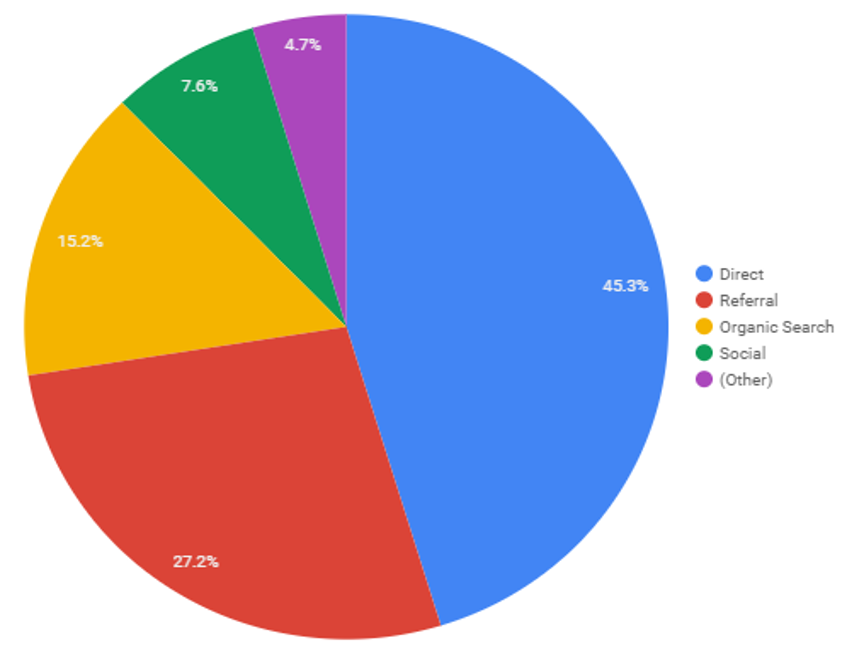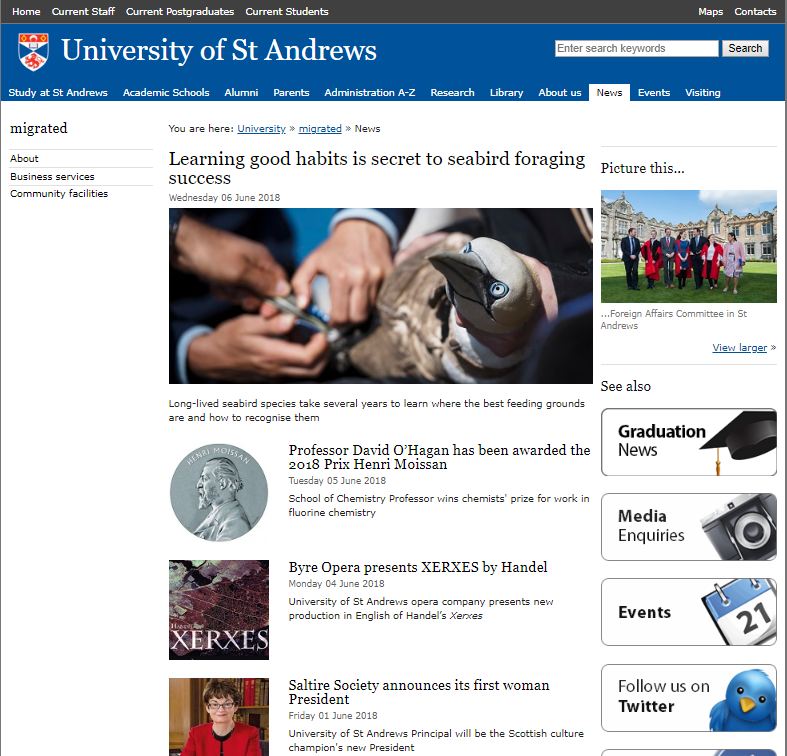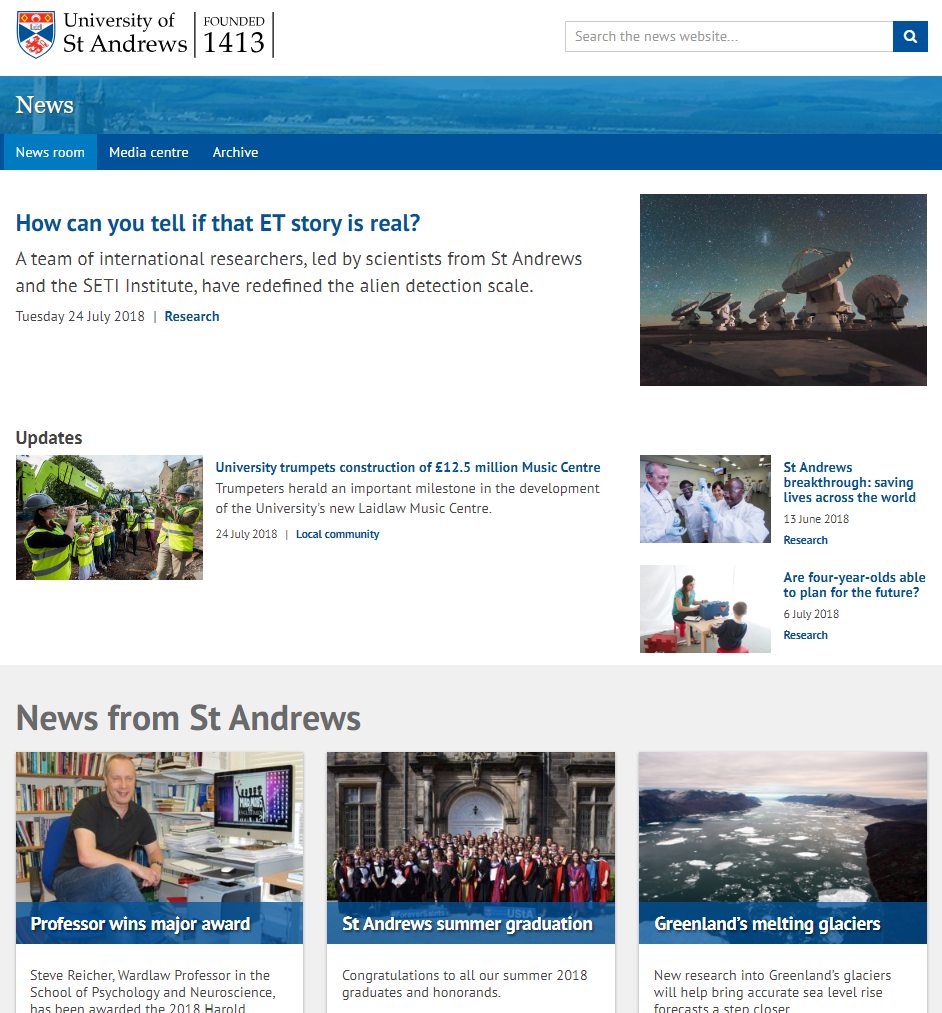News and media centre website
The new website for news and media was launched on 7 June 2018. The new website provides a number of enhancements over the old site. For example:
- news can be categorised and tagged so it’s easier to find
- news can be shared on social media
- users can make comments on news
- news can be viewed on mobile devices
- news can be published instantly.
Over one month on, we carried out usability testing and analysis of website traffic to evaluate how effective the improvements have been.
Original site
The original news site was managed by Terminal 4 version 7 (T4v7). Due to the way publishing was configured on our servers, it meant that the news team could not make instant changes to news or precisely schedule when news would go live. The design was optimised only for desktop. There was no easy way to search for news items and when news was found it could not be shared easily on social media channels.
New site
The new site is hosted in WordPress. This means that the news team can make instant changes to news items and precisely schedule when they want news to go live. The design uses our digital pattern library so it can now be viewed more easily on a range of different devices.
By using WordPress we can take advantage of the categorisation and tagging features built into WordPress that will make finding news a lot easier. There is now dedicated information for the media with a directory of experts who are available for interview.
Usability testing
Five participants were tested: four undergraduate and one postgraduate student. The participants were recorded while asking to complete the following tasks:
- You are interested in learning more about current news related to the University. Where would you go to find University of St Andrews news?
- You are interested in finding the most popular University news stories. Can you show me where you would find these?
- You are interested in University news related to [local housing], could you please demonstrate how you would find a news story about local housing?
- You enjoyed reading an article and would like to share it with friends. Could you please demonstrate how you would do this?
- In your honest opinion, how did you find using the website today? How would you describe your experience?
- As a student, do you ever read University news? Could you explain why?
Overall, the students found the new site easy to navigate and were positive about their user experience. All participants found the site visually appealing, appreciating the consistency of the news site with the main University website. One participant said the website looked clean and was not ‘cluttered’.
Two participants compared it to the design of other news sites such as BBC News and The Guardian. These comparisons suggest that users digest University news in the same way they digest mainstream news. It also suggests that users have a similar expectations for the quality of University news as they do for mainstream news.
Participants were asked at the end of the test if they, as students, ever read University news. This question was used to better understand how students engage with University news, if they do at all.
All participants responded that they did read University news. Three participants stated a preference for finding University related news via social media, predominantly through Facebook. One participant stated that they do not tend to read University news unless it is a topic they are specifically interested in. Another stated that they use the news website as often as twice a week, particularly to keep up to date on local issues. This demonstrates that students typically access news stories via social media channels and that they are generally interested in stories relevant to their experiences.
Usability recommendations
There are no major usability concerns when the website is viewed on a desktop. However, this may not be the case on mobile devices, so further testing should be conducted.
As most of the participants were not regular users of the website and accessed news via social media, it is important to maintain and develop the social media presence of University news to successfully reach students.
Analysis of website traffic
A comparison was made between the old and new site for the same time period (8 June to 8 July) in 2017 and 2018. Some of the key findings can be found below.
Traffic channels
Users access the new website very differently from the old site. The change is likely due to the new site being a separate website (news.st-andrews.ac.uk) from the main University site (www.st-andrews.ac.uk). As such, any traffic from the University website is treated as referral data. The data suggests that the majority of users (78% of all referrals) will only access the news site via the University homepage.
The data also indicates that few users (8%) are accessing the news site via social media. A more effective social media presence or engagement plan could potentially increase traffic from this source.

Device usage and session duration
The new site received about 12% more mobile traffic than the main University website over the same time period. This highlights the importance of ensuring the news website is accessible on mobile devices. It also demonstrates that users are accessing the news site in a different way from the main University site. This might be due to the way users access news content more widely. For example, via social media on the move, where a mobile device is often the only option.

Conclusions
The key points gained from analysing and comparing the data of the new news website are:
- Change in most common traffic channels. Previously, organic search was the most common way users accessed news pages, but with the new news website this has shifted to direct being the most common traffic channel.
- Change in device use. Increased use of mobile phones to view the news website in comparison to how users view the main University website.
- Reduced bounce rate by five percent. Slightly more users are accessing more than one page per each session, suggesting that users are engaging with the content slightly better.
- Consistent page views. Pageviews increased marginally when compared to the same month last year, but not by any significant amount.
- User locations have not changed significantly. The United Kingdom and United States remain the most common geographical locations.
- The new news website makes it easier to find and analyse web traffic data that is specific to how users are accessing news content.
Recommendations
- Continued use of social media to engage users with the news website. This initial analysis of the website’s first month suggests that there is room to potentially increase traffic from social media.
- Continue to ensure that content is optimised for mobile devices, not only in web design but in writing style.
- Although an increased number of users are accessing the website via mobile, these users are generally spending less time on the website. This suggests they spend less time reading articles than desktop users do. As such, more content that is shorter in length would better cater to the increased levels of mobile user traffic.

